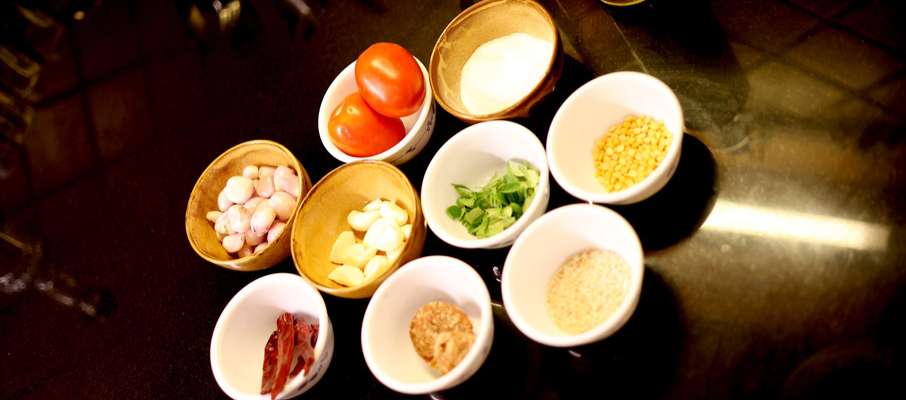
Tandoori roti, butter chicken, and aloo parathas. Suddenly, it dawned on me, that I could expand my North Indian culinary vocabulary and learn some new recipes. Not that I knew how to cook butter chicken, but if not chicken, I could easily attempt making a chutney—a South Indian chutney, perhaps? I so dearly enjoy consuming it. I could practically lick the tomato-onion chutney off the plate (pretend you don't know this about me). I can be emotionally indulgent sometimes!
Stepping out of my comfort zone has always been my favorite sport. But for now, I was helpless and on the lookout for someone to coach me. With my patent puppy eyes, I looked at the COO of Red FM, Ms. Nisha Narayanan. Only she could further my eccentricities. Thanks to her generosity, I made—or as I would like to believe—did something in her wonderful kitchen that led me to write this blog.
She had perfectly orchestrated every little detail. Here's a list of what we used:
- Coconut Oil
- Onions
- Garlic
- Tiny Tomatoes
- Red Chilies
- Coconut Oil
- Curry Leaves
- Channa Dal
- Urad Dal
- Jaggery
- Salt
The sight of all my ingredients sitting out in their respective tiny bowls reminded me of cooking classes on YouTube that my algorithm sometimes directs me to. There's something about cooking videos, especially the ASMR ones. Tch. Tch. Tch. Ah, the sound of the ladles and the fire lighting stuff up.
The first step in making chamandis was to shallow fry each ingredient separately. Because a girl has to make sure that each flavor of every ingredient is cooked to perfection. Please note that I only learned what shallow frying was when I did some real-time shallow frying.
The second step in making chamandis should have been tying up my hair, but since I totally forgot about it, we'll move to the next step instead.
Moving on, I grabbed some coconut oil. Well, I grabbed a good amount of coconut oil. It's a staple in South Indian cooking. It imparts a rich, nutty flavor to the chamandis. We started by frying tiny onions in the coconut oil until they turned golden brown. The sweetness of the caramelized onions adds a wonderful depth to the chamandi; so I was told by the wonderful host. Next, we fried the garlic cloves until they were golden and fragrant. Garlic adds a pungent kick that balances well with the other ingredients. And even for a non-chef like me, I am aware of the many wonders of garlic. There is no such thing as adding too much garlic.
It was now time to take the tomatoes and cook them until they were soft and mushy. This helped in blending the chamandi smoothly and added a tangy note.
Depending on your spice tolerance, you have free reign to adjust the number of red chilies. Since my spice tolerance is bigger than my height, I went all in. I fried them until they darkened slightly, releasing their smoky heat. I added fresh curry leaves to the hot oil and fried until they were crispy. Curry leaves are aromatic and mark their territory well, giving the distinct South Indian touch. It was time to fry the lentils (channa dal and urad dal) until golden brown for a bit of texture and nuttiness.
It was time to blend everything after frying all the ingredients individually and sweating like a pig. I put the onions, garlic, peeled tomatoes, red chilies, curry leaves, channa dal, and urad dal on a sil-batta (hand blender). To this mixture, I added jaggery for a hint of sweetness and salt to taste (namak swaad anusar)!
You can always use a blender, but for those looking to elevate the authenticity of the chamandi-making process, using a sil-batta (a traditional stone grinder) instead of a blender can provide more earthy flavors. As the expert teaching me explained, "The manual grinding process on the sil-batta extracts the oils and aromas of the ingredients more effectively, resulting in a richer, more intense chamandi."

The chutney was bursting with layers of flavors. The sweetness from the jaggery, the heat from the red chilies, the tanginess from the tomatoes, and the aroma of curry leaves all came together as the host, myself, and a few colleagues gathered to taste and tell. With the near-perfect round dosas and sambar, I decorated the lunch table with a bowl of my special chutney.
I wanted to gatekeep the chutney from everyone because who knows when I will enter the kitchen again. But I am glad I embarked on this culinary exploration. As a North Indian non-cook, stepping into this new territory was intimidating, but with the guidance of my colleague, it turned into an experience to rejoice forever.
The simplicity of the process topped the charts. Good food often comes from the freshest ingredients, cooked with care and love. The process also taught me the diversity within Indian cuisine and how food can be a bridge between cultures. Also, I have wanted till the end of the blog to say this: If I can do this, you can too!
If you try your hand at the tomato chamandi, do let us know @southsidestory.fest on Instagram, and we would love to feature your flavors!


























